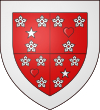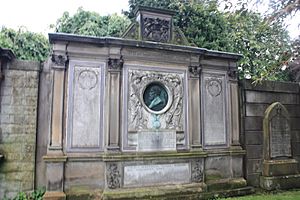Lord Belhaven and Stenton facts for kids
Quick facts for kids Lordship of Belhaven & Stenton |
|
|---|---|
 |
|
| Creation date | 15 December 1647 |
| Monarch | King Charles I |
| Peerage | Peerage of Scotland |
| First holder | John Hamilton |
| Present holder | Frederick Carmichael Arthur Hamilton |
| Heir apparent | William Richard Hamilton, Master of Belhaven |
| Remainder to | the 1st Baron's heirs male of the body lawfully begotten, failing which to his heirs male whatsoever; from 10 Feb 1675 also with remainder to John Hamilton of Presmennan and the heirs male of his body, whom failing to the nearest heirs male of John Hamilton of Presmennan whatsoever |
The title Lord Belhaven and Stenton is a special noble rank in Scotland. It's part of the Peerage of Scotland, which means it's a very old and important title. This title was first given in 1647 to Sir John Hamilton. It was meant to be passed down through his male family members.
Contents
The Hamilton Family History
This noble family comes from a branch of the well-known Hamilton family. Their story begins with John Hamilton, who lived around the 1500s. He was the half-brother of James Hamilton, 1st Earl of Arran. In 1512, John's birth was made official, meaning he could inherit titles.
His grandson, James Hamilton, became the Sheriff of Perthshire. In 1634, he received a special title called a baronet, from a group of titles known as the Baronetage of Nova Scotia. His son, Sir John Hamilton, took over the baronetcy after him. This Sir John Hamilton was the one who became the first Lord Belhaven and Stenton in 1647.
A year later, in 1648, the first Lord Belhaven and Stenton joined the Scottish army. They tried to save King Charles I and fought in the Battle of Preston.
How the Title Was Passed Down
The first Lord Belhaven and Stenton did not have any sons. So, in 1675, he gave his title back to the Crown. He then received a new agreement for the title. This new agreement said the title would go to his relative, John Hamilton of Pressmannan. John was married to the first Lord's granddaughter. If that family line ended, the title would go to other male relatives.
When the first Lord died in 1679, his baronetcy ended. But the lordship continued with John Hamilton of Pressmannan, who became the second Lord. The second Lord was a great-great-great-grandson of an earlier John Hamilton.
When the second Lord died, his son became the third Lord. This third Lord was a Scottish Representative Peer in the House of Lords from 1715 to 1721. In 1721, he was made Governor of Barbados, but sadly, he drowned on his way there. He had four sons and one daughter.
His oldest son, John Hamilton, became the fourth Lord. He died in 1764 without marrying. His next brother, Andrew, had died earlier. So, the title went to the third son, James Hamilton, who became the fifth Lord. When James died in 1777, the line of the second Lord ended. This was because the youngest son, Robert, had also died in 1743.
Disputes Over the Title
After the fifth Lord died, there was a disagreement about who should get the title next. In 1777, a Captain William Hamilton wrongly thought he was the next Lord. He was a distant relative. He even voted in an election for Scottish Peers in 1790.
However, in 1793, a special committee of the House of Lords decided his vote was not valid. They ruled that the rightful person to inherit the title was William Hamilton, who became the seventh Lord. He was the son of Robert Hamilton of Wishaw, who was considered the true sixth Lord.
Later Lords Belhaven and Stenton
The seventh Lord was followed by his son, who became the eighth Lord. He was a Scottish Representative Peer from 1819 to 1831. He also served as the Lord Lieutenant of Lanarkshire. In 1831, he received another title, Baron Hamilton of Wishaw. This new title was part of the Peerage of the United Kingdom, which gave him an automatic seat in the House of Lords.
However, when he died in 1868, the Baron Hamilton of Wishaw title ended. The Lordship of Belhaven and Stenton then became "dormant," meaning no one was officially holding it. In 1875, the House of Lords decided that James Hamilton was the rightful ninth Lord. He was a grandson of an earlier Robert Hamilton. The ninth Lord Belhaven and Stenton also served as Lord-Lieutenant of Lanarkshire.
The ninth Lord had seven daughters but no sons. After his death, his relative Alexander Charles Hamilton claimed the title. He was the son of a geologist named William Hamilton. In 1894, his claim was accepted by the House of Lords, and he became the tenth Lord. He was a Scottish Representative Peer from 1900 to 1920.
His nephew then became the eleventh Lord. He was an officer in the Indian Army and also served as a Scottish Representative Peer from 1922 to 1945. In 1934, he added the surname Udny to his name. However, none of the Lords after him have used this extra surname.
Coat of Arms
The coat of arms for the Lordship of Belhaven and Stenton has a special design. It is divided into four parts:
- The first and fourth parts show a silver star between three white clover-like shapes on a red background. This represents the Hamilton of Udston family.
- The second and third parts show a natural-colored man's heart with gold shading, also between three white clover-like shapes on a red background. This represents the Hamilton of Raploch family.
- All these designs are surrounded by a silver border.
Hamilton Baronets of Broomhill (1634)
- Sir James Hamilton, 1st Baronet (died around 1645)
- Sir John Hamilton, 2nd Baronet (died 1679) (He became Lord Belhaven and Stenton in 1647)
Lords Belhaven and Stenton (1647)

- John Hamilton, 1st Lord Belhaven and Stenton (died 1679) (His baronetcy title ended)
- John Hamilton, 2nd Lord Belhaven and Stenton (1656–1708)
- John Hamilton, 3rd Lord Belhaven and Stenton (died 1721)
- John Hamilton, 4th Lord Belhaven and Stenton (died 1764)
- James Hamilton, 5th Lord Belhaven and Stenton (died 1777)
- Robert Hamilton, 6th Lord Belhaven and Stenton (1731–1784)
- William Hamilton, 7th Lord Belhaven and Stenton (1765–1814)
- Robert Montgomery Hamilton, 8th Lord Belhaven and Stenton (1793–1868) (The title became dormant in 1868)
- James Hamilton, 9th Lord Belhaven and Stenton (1822–1893) (The title was officially brought back in 1875)
- Alexander Charles Hamilton, 10th Lord Belhaven and Stenton (1840–1920)
- Robert Edward Archibald Udny-Hamilton, 11th Lord Belhaven and Stenton (1871–1950)
- Robert Alexander Benjamin Hamilton, 12th Lord Belhaven and Stenton (1903–1961)
- Robert Anthony Carmichael Hamilton, 13th Lord Belhaven and Stenton (1927–2020)
- Frederick Carmichael Arthur Hamilton, 14th Lord Belhaven and Stenton (born 1953)
The person expected to inherit the title next is the current Lord's son, William Richard Hamilton (born 1982).
See also

